Michael Delahoyde
Originally published in THE OXFORDIAN, Volume IX 2006, pages 51–65
To this well-painted piece is Lucrece come,
To find a face where all distress is stell’d.
Many she sees where cares have carvéd some,
But none where all distress and dolour dwell’d
Till she despairing Hecuba beheld, …
Lucrece (lines 1441-45)
Shakespeare’s two long narrative poems, despite their original popularity in the 1590s and beyond, receive scant attention in general, especially among those involved in the authorship controversy. Orthodoxy has little to say about the poet’s motive for writing Lucrece (the original title on the 1594 first quarto, and for the next four editions). One senses that the Stratfordian perspective on the poem is similar to that more extreme view of the Sonnets, that Lucrece was no more than an arbitrary writing exercise. And one on which Shakespeare earned a C-minus, given the awkward intrusion of the long and seemingly pointless tangent describing Trojan War paintings, amounting to about one ninth of the entire poem and placed smack in the middle of Lucrece’s raw grieving! Nor have Oxfordians fared much better than Stratfordians in providing some explanation for the long detour or for the poem itself.
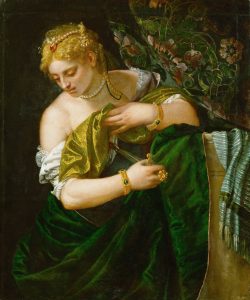
Charlton Ogburn, Jr. senses an allegory of the relationship between the Queen and young Oxford respectively in Venus and Adonis (512, 523), while more recently Roger Stritmatter expands on Ogburn’s reading at some length (“A Law Case in Verse”). But Ogburn says nothing about the contents of The Rape of Lucrece. His parents, the elder Ogburns, had themselves offered very little about the poem, apart from an oblique speculation that the poet may indirectly have described himself as the rapist Tarquin: “Venus and Adonis tells of a woman’s lust, Lucrece of a man’s” (845), while in the latter, a woman “famous for chastity” is assaulted by a man “of excessive pride” (859). Even if this were convincing as a possible artistic impulse, it turns the poem into an arbitrary exercise, one that any skilled poet might have written.
Eva Turner Clark silently omits these poems from her chronological matching of historical events with de Vere’s works. And no threaded discussions concerning Lucrece independent of my own have appeared yet on the online discussion forum of the Shakespeare Fellowship. Recently, Mark Anderson has provided the suggestion that the poem has something to do with Queen Elizabeth’s decline vs. the male power brokers of the Regnum Cecilianum (278-9), though somehow, on another level, traces of Oxford’s wife Anne also play a part (51, 146). William Farina confines his discussion almost exclusively to sources and background, venturing only so far as to mention the theme of lost honor and reputation and to acknowledge that Oxford was accused of rape by the traitors about whom he warned the Queen (225). These connections are extremely weak.
Yet the poem certainly warrants an anti-Stratfordian examination. That Ovid’s Fasti, which served as the key source for Lucrece, had not been translated in Shakespeare’s time means that he had to have read it in the original Latin (Michell 24),[1] yet another biographical miracle if viewed from Stratford.
Because Lucrece is such an enigma, both Stratfordian and anti-Stratfordian attentions have focused on the dedication to Southampton, and thus speculations about the composition of the poem have remained grounded at the 1594 publication date. Yet the rhetorical style of the poem, with lines such as “In darkness daunts them with more dreadful sights” (462) or “Muster thy mists to meet the eastern light” (773) suggest an earlier composition. By the mid-nineties, with the passing of Greene, Lyly, and Lodge, such mannerisms had become passé.
But what is the purpose of this poem? Why, when the work is praised for its dramatic quality, was it not written as a play in the first place? And why choose this particular episode from ancient Roman history? The significance of the rape of Lucrece traditionally involved its function as the last straw before pre-Republic Rome threw off its early tyranny (Empson 8-9). In Lucrece, acknowledgment of these political ramifications is confined to the prose prelude labeled “The Argument”: “with one consent they all vowed to root out the whole hated family of the Tarquins” (38-39). “The Argument” provides this historical context, along with the story’s premise and the plot set-up. If it seems obligatory, it’s because we cut so abruptly and immediately into the narrative with the first lines of the poem:
From the besieged Ardea all in post,
Borne by the trustless wings of false desire,
Lust-breathed Tarquin leaves the Roman host,
And to Collatium bears the lightless fire
Which in pale embers hid, lurks to aspire,
And girdle with embracing flames the waist
Of Collatine’s fair love, Lucrece the chaste. (1-7)
Answers to the most significant questions regarding this enigmatical work can be found if we begin with the most noticeable device Shakespeare uses to characterize Lucrece early in the poem, one Nancy J. Vickers discusses in her 1999 article: “This heraldry in Lucrece’ face,” a line from the poem. Vickers shows that “Shakespeare expands his imagistic network by exploiting the highly codified vocabulary of heraldic convention” (173), in this case color, a word, Vickers notes, that appears more often in this poem than in any other Shakespearean text (179). From as early as the second stanza of the work, Lucrece is associated repeatedly with two colors:
Collatine unwisely did not let
To praise the clear unmatched red and white
Which triumph’d in that sky of his delight. . . . (10-12)
In the very stanza that “Lust-breathed Tarquin” first sets eyes on Lucrece, the two colors become animated:
Well was he welcom’d by the Roman dame,
Within whose face beauty and virtue strived
Which of them both should underprop her fame.
When virtue bragg’d, beauty would blush for shame;
When beauty boasted blushes, in despite
Virtue would stain that o’er with silver white. (51-56)
The conceit continues for another stanza with red and white activated as separate forces and vying for dominance. The poet then sums up:
This heraldry in Lucrece’ face was seen,
Argued by beauty’s red and virtue’s white;
Of either’s color was the other queen,
. . .
The sovereignty of either being so great
That oft they interchange each other’s seat. (64-70)
“This silent war of lilies and of roses” (71), or between white and red, will reappear later when Lucrece worries about her husband (258-59) and again when Tarquin first sees her asleep: “Her lily hand her rosy cheek lies under” (386).
Although this litany of pure white skin flushed with red is heard in reference to many a “peerless dame” in other poems of the time, this one does seem to point to Queen Elizabeth. With words such as queen and sovereignty associated with the struggles between red and white, what English contemporary of Shakespeare’s would not have been reminded of the Wars of the Roses, brought to a conclusion by the union of Yorkist white with Lancastrian red as symbolized by the variegated Tudor rose, of which that paragon of chastity, the Queen herself, was the living representation? The poet’s reference to “thy never-conquered fort” (482), after yet another assertion of the red and white (478-79), seems to be Tarquin’s blatantly sexual metaphor for Lucrece’s virtue. “Never-conquered” seems inappropriate for Lucrece, who after all is married. It would, however, be appropriate for the “Virgin Queen.”
In any case, an allegorical subtext suggesting Elizabeth as the exemplar of chastity raises the question: who does Shakespeare feel is such an enemy to the Queen or such a national threat that he indirectly portrays him as a rapist? “O shame to knighthood,” the poet calls him: “A martial man” (179-200). Tarquin himself seems to plant a clue during his pre-rape ruminations:
Yea, though I die, the scandal will survive,
And be an eye-sore in my golden coat;
Some loathsome dash the herald will contrive
To cipher me how fondly I did dote. . . . (204-207)
It’s clear the Tarquin figure is someone of great pride in his heritage.
The narrator frequently interjects comments less appropriate to the plot at hand than suggestive of political machinations at the Elizabethan court:
Or what fond beggar, but to touch the Crown,
Would with the scepter straight be stricken down? (216-217)
Thus treason works ere traitors be espied. (361)
Shakespeare seems to have forgotten that it was the rapist Tarquin who was the monarch, not Collatine or his wife.
Despite Tarquin’s lengthy inner debate in which he presents the many reasons for turning back, he continues to proceed onward towards Lucrece’s bedroom, encountering along the way some “night-wand’ring weasels” (307), household pets kept by Renaissance magnates to control the vermin population in the many dark rooms and halls of their mansions. Thus Shakespeare connects Tarquin in our minds with one of these weasels, even, perhaps, since they “fright” him, with one of the vermin they are meant to control.
He enters Lucrece’s bedroom. She awakes and, horrified, recognizes his intent. Despite her anguished protests and lengthy attempts to reason with him, he rapes her.
After he departs she delivers apostrophes to Night, Opportunity, and Time and determines to commit suicide. First, however, she turns her attention to some “skillful painting, made for Priam’s Troy” (1367): “A thousand lamentable objects there, in scorn of nature, art gave lifeless life” (13731374). The section amounts to about one ninth of the poem and traditionally is dismissed as an embarrassing flaw from the young, unseasoned Shakespeare, a pointless digression, at best a less than felicitous device whereby a necessary amount of time may pass in the narrative.
The consensus for approximately the last century is that for this long section of the poem describing the Trojan War art, Shakespeare was inspired, somehow, by the work of Giulio Romano (c.1492-1546). It seems the connection was found first in 1894 by Gregor Sarrazin (Hamill 13). Romano is the only artist Shakespeare ever mentions by name. In The Winter’s Tale, a “gentleman” comments on “that rare Italian master, Julio Romano, who . . . would beguile Nature of her custom” (5.2.97ff).[2]
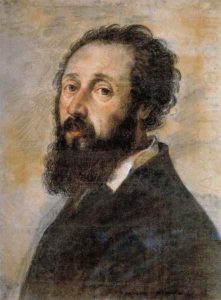
That Shakespeare identified Romano as a sculptor, not a painter, was once considered an example of Shakespeare’s ignorance. Traditional criticism sighed in relief that the uneducated William doesn’t know what he’s talking about regarding continental art. But, as with Italian waterways (Grillo 144) and Bohemian seacoasts (Anderson 86), Shakespeare has again been vindicated. As it turns out, Giulio, an exemplar of the “Renaissance Man,” was not only a painter, an architect, and an interior designer, he was also a sculptor. His multimedia abilities present yet another dilemma for Shakespearean orthodoxy. As John Michell puts it: “the author of The Winter’s Tale [would have to have] learnt that Giulio was a sculptor by reading the original Latin epitaphs on the tombstone at Mantua” (225). There was no other way he could have known it.
So, was Shakespeare ever in Mantua? Lionel Cust, known for helping establish the consensus regarding Giulio’s work as the source for the Lucrece paintings, explains it this way:
In the poem Lucrece, a “piece of skilful painting” of the siege of Troy is described in detail and at considerable length (ll. 1366-1456). At Mantua, the painter Giulio Romano (in addition to his renowned paintings in the Palazzo del Tè) executed in the castle, between 1532 and 1536, a famous series of paintings of the Trojan War, the wonders of which may have been described to the young Shakespeare and may have impressed themselves on his imagination. (9-10)
Was a sailor, perhaps, just returned to London, having somehow gained access to the ducal palace in Mantua, so inspiring in his description to his drinking buddies at the Mermaid Tavern of the palace art, that Shakespeare rushed back to his rooms to insert the material into (and structurally ruin) the narrative poem he was currently composing?
Although we have no letters from de Vere posted from Mantua during his tour of the Continent in 1575-76, it is inconceivable that he missed it. A stone’s throw from Verona, in the heart of the northern Italian region of Lombardy, an area with which he obviously fell in love, Mantua, aside from being the birthplace of Virgil, must have held a particular attraction for the twenty-five year-old Earl of Oxford. As Ruth Loyd Miller noted, “No courtier of the Court of Elizabeth I, traveling in Italy, would have failed to visit the tomb of Baldassare Castiglione, author of The Courtier. The tomb of Castiglione, designed by Romano, was at Mantua” (qtd. in Clark 239). Oxford’s interest would have been particularly keen since he had written an elegant Latin introduction to Bartholomew Clerke’s Latin translation of Il Cortegiano two years before he began his travels.
Giulio Romano had arrived in Mantua from Rome in 1524 “personally recommended and escorted by the Gonzagas’ cultural agent in Rome, Baldassare Castiglione” (Paoletti 396). Attempting to be open-minded in evaluating the authorship candidates, Michell asserts:
A traveler who was so interested in Giulio Romano that he went to see his tomb and noted the inscription on it would certainly, while in Mantua, have gone to the famous Palazzo del Te, built by the artist himself and filled with his paintings and drawings. Exhibited there were Giulio’s great pictures of the Trojan War. This work has been identified (by Lionel Cust in his contribution to Shakespeare’s England) as the original of the Trojan War painting which Shakespeare wrote about in The Rape of Lucrece (lines 1366-1456). Cust was prevented by Orthodoxy from concluding that Shakspere had been to Mantua and seen Giulio’s work for himself, so he suggested that someone else had told him about it. That is always a possibility, but the picture in Lucrece is described at such length and with so much spirited detail, that it seems far more natural to suppose that the poet saw the original with his own eyes. It is difficult to work up such enthusiasm second hand. (225)
Despite his accurate interpretation of the artistic nature, Michell repeats an error that shows up frequently in discussions of the poem. The Palazzo Te[3] in Mantua is where the Gonzaga family retired occasionally for pleasure. It contains the Sala di Psiche (the Room of the Mind), the Sala Dei Giganti (the Room of the Giants), and other well-known paintings and decorations by Romano. But the Palazzo Te is not identical with the ducal palace, the Palazzo Ducale, a cluster of buildings a mile to the north, where the Gonzagas actually lived and where the Sala di Troia (Room of Troy) is to be found, “one of eight rooms in the Appartamento di Troia of the Corte Nuova that Giulio and his assistants remodeled and redecorated between 1536 and 1539” (Wohl 237).
De Vere’s host in Mantua would have been the third duke, Guglielmo, the second son of Federigo (or Federico), who ruled Mantua from 1540 to 1587 (Le Riche, qtd. in Clark 242). Guglielmo liked showing off the accomplishments of the artists patronized by his parents (Simon 227, Magri 61), and Giulio Romano’s architectural achievements were famous. As for the frescoes: “The reason why these . . . paintings so impressed [Shakespeare] (if he visited Mantua) would have been because they are so different from the abundance of other paintings in Italy which portray religious subjects” (Le Riche, qtd. in Clark 241). Giulio’s “creations are known for their vitality, illusionism and theatrical splendour” (239). Coming from England and its artistic deprivations, where painting more or less amounted to (poor quality) portraiture, any Englishman of taste, particularly one who was himself an artist, would have been dazzled by the lush power of such works, while a healthy twenty-five-year-old, coming from the sexually repressed climate of the English Reformation, would have been dazzled by their unabashed sexuality. Since Romano also designed costumes for masquerades and court performances of Latin and Italian plays, for jousts, tournaments, and festivals in Mantua (Magri 52), it has been suggested that his dramatic painting style was fostered by his involvement in the theater.
Also appealing to the man who would be Shakespeare was Romano’s treatment of ancient history and mythology. In other works, such as the Trojan War tapestries of Tournai, woven in the late fifteenth century, “antiquity was imagined as legendary and remote. Giulio, by endowing the image of antiquity with the resources of chiaroscuro illusionism . . . transposed it into the present” (Wohl 238). In the same way it becomes a guiding principle for Shakespeare, that ancient stories, if brought to life, can make powerful if subtle comments on contemporary situations.
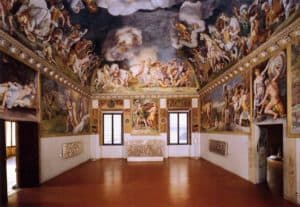
Just as in the painting described in Lucrece, Giulio’s painting is busy with scenes depicting dramatic activity and the chaos of war. The walls and ceiling of the Sala di Troia show Paris and Venus after his judging of the goddesses, Il Ratto di Elena (The Rape of Helen), Minerva aiding the Greeks, Venus protecting Aeneas, Ajax the Lesser struck by lightning, Venus swooning in the arms of Jupiter, and the numerous triumphs of Diomedes, including his slaying of Pandarus. Romano’s emphasis is on the fifth book of Homer’s Iliad, considered an aristeia for Diomedes, meaning, “a particularly good day”––the literary version of a peak experience. Although critics have traditionally insisted that there is no evidence that the paintings were “intended as an allegorical glorification of the Gonzaga dynasty” (Wohl 238), the numerous paintings featuring Diomedes suggests that Giulio Romano may have been honoring Federigo, Guglielmo’s father, as a modern Greek-style hero.[4]
Lucrece comes from the portrayal of La Lotta per le Armi di Patroclo (“The Struggle over the Armor of Patroclus”) showing an older Greek soldier, holding the corpse of Patroclus, which has been stripped of the borrowed armor of Achilles (left and cover). Amid the chaos and directly above the corpse, appears a figure Shakespeare seems to be describing in Lucrece––
For much imaginary work was there,
Conceit deceitful, so compact, so kind,
That for Achilles’ image stood his spear,
Gripp’d in an arméd hand, himself behind
Was left unseen, save to the eye of mind. (1422-26)
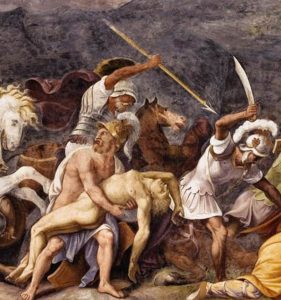
––a description that perfectly fits the image, the figure gripping the spear, his face hidden by his upraised arm, as if the artist, in a conflation of narrative time, intends to depict “the wrath of Achilles,” this time over the death of Patroclus. Having published for the first time under the name “Shakespeare” only a few months earlier, recalling the painting as he wrote, the image of the mighty Achilles, arm upraised but face hidden, holding the threatening spear, would have seemed significant to Oxford, as perhaps he hoped it might for readers wondering who this unknown “shake-spear” was who had come out of nowhere to publish, first, the brilliant narrative poem Venus and Adonis, and now this second, equally brilliant, narrative poem.
In Lucrece, Shakespeare demonstrates his fascination with finding contemporary relevance in ancient narratives. Just as Hamlet, his alter ego, asks the First Player to recite a different Trojan War episode (Priam’s slaughter and Hecuba’s despair), which moves him to tears over his own situation (while it bores Polonius) (2.2.), Lucrece applies the Trojan War imagery to her own situation:
Show me the strumpet that began this stir,
That with my nails her beauty I may tear.
Thy heat of lust, fond Paris did incur
This load of wrath that burning Troy doth bear;
Thy eye kindled the fire that burneth here,
And here in Troy, for trespass of thine eye,
The sire, the son, the dame, and daughter die.
Why should the private pleasure of some one
Become the public plague of many more? (1471-1479)
That Lucrece would have reason to blame Helen for her own rape derives from the ancient tradition that it was Helen’s goddess-like beauty that brought into the world such troubles between mortal men and women; that before Helen’s fatal attraction, men were respectful of women and of each others’ wives. But note her passionate impulse: she wants to scrape at the image of Helen with her fingernails.
Her reaction to another character in the painting she scrutinizes is also of interest. Sinon was the devious Greek left behind on the Trojan shore when the Greek fleet pretended to depart but actually hid behind an island. Sinon was a plant left behind so that he could dupe the Trojans into accepting the wooden horse inside their city. Lucrece processes the implications here:
The well-skill’d workman this mild image drew
For perjur’d Sinon, whose enchanting story
The credulous old Priam after slew.
. . . .
“It cannot be,” quoth she, “that so much guile” ––
She would have said, “can lurk in such a look,”
But Tarquin’s shape came in her mind the while.
. . . .
“Look, look how list’ning Priam wets his eyes,
To see those borrowed tears that Sinon sheds!
Priam, why art thou old, and yet not wise? . . .”
. . . .
Here all enrag’d, such passion her assails
That patience is quite beaten from her breast,
She tears the senseless Sinon with her nails,
Comparing him with that unhappy guest
Whose deed hath made herself herself detest. (1520-1566)
Thus Sinon, whom incidentally the poet describes as having “cheeks neither red nor pale” (1510), becomes a kind of Tarquin figure for Lucrece. She has a new appreciation for the art now that she can “read” its relevance, though not the sort that restrains her from violently attacking the work itself. This time, Lucrece does use her nails to scrape at the image of the villain.
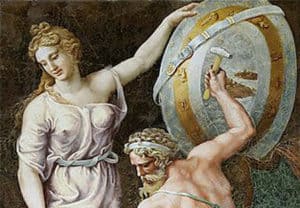
One remaining image in the Sala di Troia seems more than any other the key to Lucrece. The space above each of the two doorways appears to have been devoted to especially important images. Above one doorway is Hephaestos forging the shield of Achilles rendered in impressive detail from Book 18, which is devoted to Homer’s overview of the ancient Greek world as depicted on the face of the shield, showing how well Giulio knew his Iliad and his Eustathius of Thessalonica, whose Commentarii ad Homeri Iliadem provided the detail concerning the zodiac at the rim of the shield (Talvacchia 240).
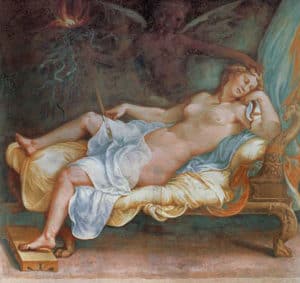
Above the other door is Il Sogno di Ecuba: “the Dream of Hecuba,” Romano’s depiction of the first of two ominous dreams or visions that disturbed the Queen of Troy. Giulio chose to depict the first, since the latter takes place after the fall of Troy when Hecuba would have had no access to all the luxuries shown in this image. The significance of Giulio’s depiction is immediately striking: it could easily serve as the frontispiece for an edition of Lucrece, for Hecuba is rendered just as Shakespeare describes Lucrece when Tarquin approaches her––sleeping naked, breasts exposed (407), her golden hair loose (400). The nightmarish figure giving Hecuba her dream resembles Tarquin in its stance, hovering over her (421) seemingly threatening to rape her with a phallic-like stave. Her dream tells her that if the child she is carrying (Paris) lives, he will be a “fire-brand” who will bring about the destruction of Troy (cp. Troilus and Cressida 2.2.110).
The other Sogno di Ecuba, though not depicted, has relevance as well. Hecuba has a premonition of events about to come to light after the fall of Troy. She has by this point faced the deaths of dozens of her sons. Her husband has been slaughtered before her eyes at the altar of the sacred temple of Troy. Her city is in ashes. All the surviving women of Troy, including herself, have been taken into slavery by the conquering Greeks. Her one slim consolation is that some time ago she and Priam, in the remote case that the worst should befall, sent their youngest son Polydorus away to live in safety with an ally, Polymestor, King of Thrace. But Polymestor, upon hearing of the annihilation of Troy, took Polydorus’s goods, slit his throat, and heaved his corpse into the sea.
When the body of her only remaining son washes ashore in front of Hecuba, she is eerily silent. She arranges to meet with Polymestor privately, indicating that she knows the location of the remaining hidden Trojan treasure. Getting the murderous opportunist in a tent alone, she suggests that he retrieve the treasure for the young Polydorus. He readily agrees, not realizing that she knows that Polydorus is dead. The Golding translation of Ovid’s Metamorphoses describes what follows:
…Upon him speaking so,
And swearing and forswearing too, she lookéd sternly though,
And being sore inflamed with wrath, caught hold upon him, and
Straight calling out for succor to the wives of Troy at hand
Did in the traitors face bestow her nails, and scratchéd out
His eyes. Her anger gave her heart and made her strong and stout.
She thrust her fingers in as far as could be, and did bore
Not now his eyes (for why his eyes were pulléd out before)
But both the places of the eyes bewray’d with wicked blood. (13.669-677)
Hecuba, known for this final act of digging at Polymestor’s hollow eye-sockets with her fingernails, serves again as a source for Shakespeare’s portrayal of Lucrece, who when distraught is similarly given to gouging with her nails.
Here parallels between the Sala di Troia and the poem end. After the depiction of Sinon duping the Trojans about the wooden horse, the only scene chronologically later in the story is Giulio’s painting of Laocoön and the sea-serpent. He does not show the fall of Troy. In the Lucrece narrative, her husband Collatine and others arrive, and Lucrece commissions them as avengers (1690f). Their perspective is that “Her body’s stain her mind untainted clears” (1710), but she disagrees. Unable to speak Tarquin’s name, she stabs herself. Old Lucretius, her father, laments, and he and Collatine play tug-of-war for “ownership” of the late Lucrece, each vying for their claim to the greater grief.
Near the end of the poem and out of left field emerges Brutus, an interesting character who apparently adopted a Hamlet-like “antic disposition” for purposes of political survival:[5]
He with the Romans was esteeméd so
As seely jeering idiots are with kings,
For sportive words, and utt’ring foolish things. (1811-13)
Now, however, he “Began to clothe his wit in state and pride, burying in Lucrece’ wound his folly’s show” (1809). This Brutus, ancestor to the Brutus in Julius Caesar, is reputed to be a fool:
But now he throws that shallow habit by,
Wherein deep policy did him disguise,
And arm’d his long-hid wits advisedly,
To check the tears in Collatinus’ eyes.
“Thou wrongéd lord of Rome,” quoth he, “arise,
Let my unsounded self, suppos’d a fool,
Now set thy long-experience’d wit to school. (1814-20)
If the spear-shaking Achilles with the hidden face is a kind of signature, Brutus may be a cameo. As Eva Turner Clark has pointed out, the “allowed fool” is a familiar figure in Shakespeare, such as the clown Feste in Twelfth Night, “someone in Court who is permitted to take great liberties of speech” (370). Brutus’s feigned madness seems insufficiently motivated or explained in the poem, but it reassures the reader that sometimes he who is dismissed as an irresponsible fool may in fact have the makings of a great leader: the Prince Hal phenomenon. When Brutus removes the knife from Lucrece’s body, the blood travels in two directions:
. . . the crimson blood
Circles her body in on every side,
Who like a late-sack’d island vastly stood
Bare and unpeopled in this fearful flood. (1738-1741)
Most women would balk at being compared to a land mass, but if the allegorical identification is to Elizabeth it is appropriate to conflate her with the island she rules, and thus, indirectly but gruesomely, the dire consequences of trusting a Tarquin. Brutus offers an encouraging speech to Collatine, drumming up an avenging spirit among the men, who vow to escort Lucrece’s body through Rome “And so to publish Tarquin’s foul offence” (1852). The Roman people support “Tarquin’s everlasting banishment” (1855), and so the poem ends.
Lucrece, then, may be an allegorical emergency alert. Through Lucrece’s interaction with the Trojan War painting, Elizabeth is being warned about a Sinon whom the head of state, Priam––who seems to be a Burghley figure, given the poet’s lament that old age doesn’t bring wisdom (1550)–– foolishly trusts. As Lucrece sees her situation in Troy’s and Hecuba’s, so too should Elizabeth see her situation in Lucrece’s. England, whose capital city was known traditionally as New Troy, needs to avoid replicating its ancestral city’s disastrous fall. And just as Troy had its Sinon and ancient Rome its Tarquin, so too is there a villain positioned dangerously in England now.
Who among Elizabeth’s favorites would Oxford wish to cast as a threat or as a Sinon/Tarquin figure that he should warn the Queen about? If we may credit the poet/playwright’s associative patterns, it may be significant that the name Lucrece occurs twice in Twelfth Night, both at the point in the plot when Lady Olivia’s steward Malvolio discovers the cryptic love letter forged and dropped in his path to delude him into believing Olivia is in love with him. He thinks he recognizes her handwriting on the envelope and next sees that it is sealed: “By your leave, wax. Soft! And the impressure her Lucrece, with which she uses to seal. ’Tis my lady” (2.5.91-93).
Apparently, Olivia’s seal presses an image of Lucrece into the sealing-wax. Malvolio then reads the poem inside; in other words, he has broken the seal, and so has violated the letter (has raped the Lucrece?). The other Lucrece reference appears in the text of the same letter:
I may command where I adore,
But silence, like a Lucrece knife,
With bloodless stroke my heart doth gore;
M.O.A.I. doth sway my life. (2.5.104-107)
It is frustrating that this Lucrece reference appears so close to a four-letter cipher that has yet to be explained. In any case, it has been convincingly argued that Twelfth Night is the play referred to as “a pleasant conceit of Vere, Earl of Oxford, discontented at the rising of a mean gentleman in the English court, circa 1580” (Peck qtd. in Ogburn 386), suggesting that Malvolio represents the courtier Sir Christopher Hatton, an early rival of de Vere for the Queen’s attentions.[6] Depending on when the poem was written, Tarquin may have represented the duc d’Alençon, whose proposed marriage to Elizabeth caused a great deal of uproar circa 1579-81. Some might suggest that Tarquin was Oxford’s longtime rival, the Earl of Leicester, or his cousin Henry Howard, later Earl of Northampton, or a later rival, Sir Walter Raleigh.
Ultimately, it matters less who exactly Oxford may have had in mind as a danger to the realm than that Lucrece, with its “tangent” into Trojan War paintings, shows us how to go about reading and interpreting a Shakespeare work. E.T. Clark believed that many plays, such as Richard II, beyond their topicalities, were meant to serve as warnings to Elizabeth, in this case potential disasters due to trusting the wrong people (151). Despite the indecorous implications in writing The Rape of Lucrece as such a warning, Oxford was actually “going by the book”––that being The Book of the Courtier by, again, our Mantuan friend Castiglione, a book first published in England in 1561 (translated by Sir Thomas Hoby, brother-in-law of Oxford’s father-in-law, William Cecil Lord Burghley). In The Courtier Oxford could have read his own job description:
I think then that the aim of the perfect Courtier . . . is so to win for himself . . . the favor and mind of the prince whom he serves, that he may be able to say, and always shall say, the truth about everything which is fitting for the prince to know, without fear, or risk of giving offense thereby; and that when he sees his prince’s mind inclined to do something wrong, he may be quick to oppose, and gently to make use of the favor acquired by his good accomplishments, so as to banish every bad intent and lead his prince into the path of virtue. . . . [C]ertain it is that man’s mind tends to the best end, who purposes to see to it that his prince shall be deceived by no one, shall hearken not to flatterers or to slanderers and liars, and shall distinguish good and evil, and love the one and hate the other. (2299)
This mandate Oxford earnestly and honorably and with consummate artistry did his best to live up to, most of all when it meant exposing those Tarquins who took their principles from that other famous sixteenth-century advice-book, Il Principe. To treacherous back-stabbing Machiavellian knaves, Oxford must indeed have seemed a “monstrous adversary”––and a good thing he was, for England and for English literature.
The Oxfordian IX (2006)

Dr. Michael Delahoyde has been teaching English at Washington State University since 1992 and Shakespeare courses there since 1999. He has earned degrees in English, Music, and Education at Vassar College and a PhD in English at the University of Michigan. Delahoyde has published articles on Chaucer and other topics as well as articles on film and music. He has given papers for several years at the Shakespeare Authorship Conference at Concordia University in Portland, Oregon. He is one of the editors of the Rocky Mountain Review of Language and Literature.
Endnotes
- [Editor’s note: Oxfordians can point to the fact that Ovid’s Fasti, in Latin, was among the titles in the 1566 library list of Sir Thomas Smith, Oxford’s tutor (Strype 276), the library accessible to Oxford up to age twelve.][↑]
- There may be a second reference to Giulio Romano in the canon, obscured beneath corrupted text. In Love’s Labor’s Lost is a mention of “This wimpled, whining, purblind, wayward boy; this senior-junior giant dwarf Dan Cupid” (3.1.179-180). The antithetical “senior-junior” matches “giant dwarf” but the fact that a variant reads “signior Iunios” suggests that an early editor did not recognize the reference in what was probably Shakespeare’s original line: “This Signior Julio’s giant dwarf, Dan Cupid.” The reference is to a grotesque dwarf figure that Giulio Romano added to Raphael’s Battle of Constantine and whose head he repeated in his Gigantomachy in Mantua (Miller qtd. in Clark 239-241).[↑]
- Formerly known as the Palazzo del Te, today it’s referred to as the Palazzo Te.[↑]
- More recent scholarship has reversed the traditional assessment, arguing that indeed the Sala di Troia’s odd pro-Greek orientation (in Virgil’s home town) was intended to honor Federigo Gonzaga’s military triumphs.[↑]
- [Editor’s note: As Earl Showerman shows in his article in the 2004 issue of The Oxfordian, this Brutus was also used by Shakespeare to help create the character and motivations of Hamlet (105-05).][↑]
- The name Lucrece occurs elsewhere in the canon (Titus Andronicus 2.1.108, 4.1.64, 91; Taming of the Shrew 2.1.296; As You Like It 3.2.148) but never with the import and enigmatic quality as in Twelfth Night.[↑]
Note: Photos of Giulio Romano’s paintings courtesy of Frederick Hartt.
Works Cited
Anderson, Mark. “Shakespeare” By Another Name. New York: Gotham-Penguin, 2005.
Castiglione, Baldassare. The Book of the Courtier. Literature of the Western World. Ed. Brian Wilkie and James Hurt. Vol 1. 5th ed. Upper Saddle River, NJ: Prentice-Hall, 2001.
Clark, Eva Turner. Hidden Allusions in Shakespeare’s Plays. 1931. Ed. Ruth Loyd Miller. Port Washington: Kennikat, 1974.
Cust, Lionel. “The Fine Arts: Painting, Sculpture, and Engraving.” Shakespeare’s England. Vol 2. Oxford: Clarendon, 1917.
Empson, William. “The Narrative Poems.” Shakespeare: The Critical Complex. Shakespeare’s Poems. Ed. Stephen Orgel and Sean Keilen. New York: Garland, 1999.
Farina, William. De Vere as Shakespeare: An Oxfordian Reading of the Canon. Jefferson, NC: McFarland, 2006.
Grillo, Ernesto M. Shakespeare and Italy. 1949. New York: Haskell, 1973.
Hamill, John. “The Ten Restless Ghosts of Mantua.” Shakespeare Oxford Newsletter 39.3 (2003): 1, 12-16.
Hartt, Frederick. Giulio Romano. Vol 2. New Haven: Yale UP, 1958.
Magri, Noemi. “Italian Renaissance Art in Shakespeare: Giulio Romano and The Winter’s Tale.” Great Oxford. Gen. Ed. Richard Malim. Tunbridge Wells: Parapress, 2004.
Michell, John. Who Wrote Shakespeare? London: Thames, 1999.
Ogburn, Charlton. The Mysterious William Shakespeare: The Myth and the Reality. 2nd ed. McLean, VA: EPM, 1992.
Ogburn, Dorothy and Charlton Ogburn Sr. This Star of England. Westport, CT: Greenwood, 1952.
Ovid. Metamorphoses. Trans. Arthur Golding. 1567. Ed. John Frederick Nims. Philadelphia: Paul Dry, 2000.
Paoletti, John T. and Gary M. Radke. Art in Renaissance Italy. 2nd ed. New York: Abrams, 2002.
Shakespeare, William. The Rape of Lucrece.The Riverside Shakespeare. 2nd ed. Boston: Houghton Mifflin,1997.
Showerman, Earl. “Orestes and Hamlet: From Myth to Masterpiece.” The Oxfordian 7 (2004): 89-114.
Simon, Kate. A Renaissance Tapestry: The Gonzaga of Mantua. New York: Harper & Row, 1988.
Stritmatter, Roger. “A Law Case in Verse: Venus and Adonisand the Authorship Question.” Tennessee Law Review 72.1 (2004): 307-355.
Strype, John. The Life of the Learned Sir Thomas Smith. 1820. New York: Burt Franklin, 1974.
Vickers, Nancy J. “This Heraldry in Lucrece’ Face.” Poetics Today 6 (1985): 171-184. Rpt. in Shakespeare:The Critical Complex. Shakespeare’s Poems. Ed. Stephen Orgel and Sean Keilen. New York: Garland, 1999.
Wohl, Helmut. The Aesthetics of Italian Renaissance Art: A Reconsideration of Style. New York: CambridgeUP, 1999.


